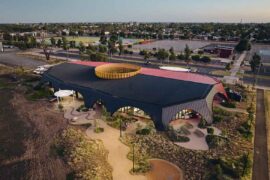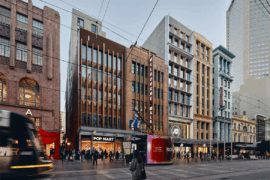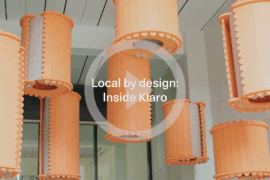Kate Goodwin, curator and Adjunct Professor (Architecture) at the University of Sydney, reports back from the AIA Conference in Melbourne.

Talaricheruvu School, Collective Project, photograph by Benjamin Hoskings.
May 16th, 2024
Close to 1000 architects from around the country gathered in autumnal Melbourne for the AIA Conference last week. The selection of international and local speakers was somewhat a menagerie, but over the course of the two days connections emerged. These were underpinned by shared global issues, most notably the ecological crisis and housing.
For several speakers, policy and advocacy came to the fore. California-based researcher and architect, Dana Cuff, showed how City Lab has developed legislature that unlocked opportunity for densifying suburban lots and later school land. She described the ten-year process interrogating the existing conditions and informal developments, then making incremental changes to planning policy.

Paul Monaghan of London practice AHMM – whose Sydney studio recently launched – spoke of the efficacy of housing design guides to raise build quality, but observed its stringency had led to homogeneity in the UK built environment. He also cited the London Plan Guidance (2023), which mandates that building retention should be the starting point for development and, if substantial demolition was proposed, applicants would need to exhaustively demonstrate that the benefits would outweigh those of retaining the existing.
Many of the stand-out projects presented intelligently integrated existing physical fabric and social histories. Amongst a vast spectrum of buildings, Monaghan showed their conversion of the 260-year-old Royal London Hospital into a town hall for a large London council. Nigel Bertram of Melbourne-based NMBW demonstrated how they approach “demolition as a creative process equal to construction” in their adaptation of a former Teachers College to a new student precinct for Melbourne University and a co-working office in an old two-storey factory. In one instance they created a garden within the new building, removing the concrete floor in a process akin to cookie cutting, using the circular offcuts across the site.
Related: Kevin Carmody at last year’s conference

Identifying the proliferation of illegal dumping of construction waste in India, Collective Project designed a spatially inventive house made from blocks created from the rubble of the old house – an act of designing both the product and production process. In another they used the offcuts from granite tile production to create a beautiful external facade. To succeed, they stress the need for client investment in these processes. It’s also worth checking out their Talaricheruvu Rural School.
Responding to the labour conditions of a developing economy, Ganga Rathnayake and Milinda Pathiraja from Colombo, Sri Lanka, described how they design and strategise the construction process to create social and physical capital. Evidenced across a range of beautiful rural and urban projects, they design buildings attuned to the local available skill levels, informing material selection and detailing with tolerances that don’t rely upon industrial precision. They also design the construction process to extraordinary detail, creating manuals to train unskilled workers on-site and staging work to start with less important areas.


For those who like their architecture with a capital A, Spaniard Alberto Viega obliged with his refined European cultural projects involving what he called “sentimental monumentality.” The approach involves a balance between place specificity and autonomy to create projects that were both contextual and abstract. The audience was left to reconcile the seductive majesty of these works with Yasmin Yari’s preceding call for architects to work on humanitarian projects and touch the earth lightly.
The conversation on AI showed the frontiers of the profession. Alisa Andrasek directed the discussion away from visual outcomes to the underlying computation systems that can deal with complexity and specificity. She described a project using AI software and robotics to develop joints that would expand the capacities and scales of prefabrication. Meanwhile, Liam Young demonstrated the breadth of disciplinary possibilities: he uses film as a site for speculative futures that interrogate how new technologies are shaping our cities and architectures.
I was impressed by the courage and humility of the younger architects, who celebrated learning in practice. Likewise, one of the many takeaways from a yarn hosted by Michael Mossman was that Indigenising the built environment involves architects and community learning together, engendering knowledge sharing and transfer.
It was clearly a forum of architects talking to architects, with questions arising about practice and ethics, scope and efficacy. Philip Thalis, Gold Medal recipient, used John Brack’s incisive observational paintings of urban life to comment on the architect’s societal responsibility and called for architects to stand up, and speak up, to be courageous based on knowledge and expertise.
Next up: Eight stories about housing and its multiple crises
INDESIGN is on instagram
Follow @indesignlive
A searchable and comprehensive guide for specifying leading products and their suppliers
Keep up to date with the latest and greatest from our industry BFF's!

For those who appreciate form as much as function, Gaggenau’s latest induction innovation delivers sculpted precision and effortless flexibility, disappearing seamlessly into the surface when not in use.

At the Munarra Centre for Regional Excellence on Yorta Yorta Country in Victoria, ARM Architecture and Milliken use PrintWorks™ technology to translate First Nations narratives into a layered, community-led floorscape.

From the spark of an idea on the page to the launch of new pieces in a showroom is a journey every aspiring industrial and furnishing designer imagines making.

Merging two hotel identities in one landmark development, Hotel Indigo and Holiday Inn Little Collins capture the spirit of Melbourne through Buchan’s narrative-driven design – elevated by GROHE’s signature craftsmanship.

Jason Gibney, winner of the Editor’s Choice Award in 2025 Habitus House of the Year, reflects on how bathroom rituals might just be reshaping Australian design.

J.AR OFFICE’s Norté in Mermaid Beach wins Best Restaurant Design 2025 for its moody, modernist take on coastal dining.
The internet never sleeps! Here's the stuff you might have missed

In an industry where design intent is often diluted by value management and procurement pressures, Klaro Industrial Design positions manufacturing as a creative ally – allowing commercial interior designers to deliver unique pieces aligned to the project’s original vision.

In the New Year, architecture will be defined by its ability to orchestrate relationships between inside and outside, public and private, humans and ecology, and data and intuition.